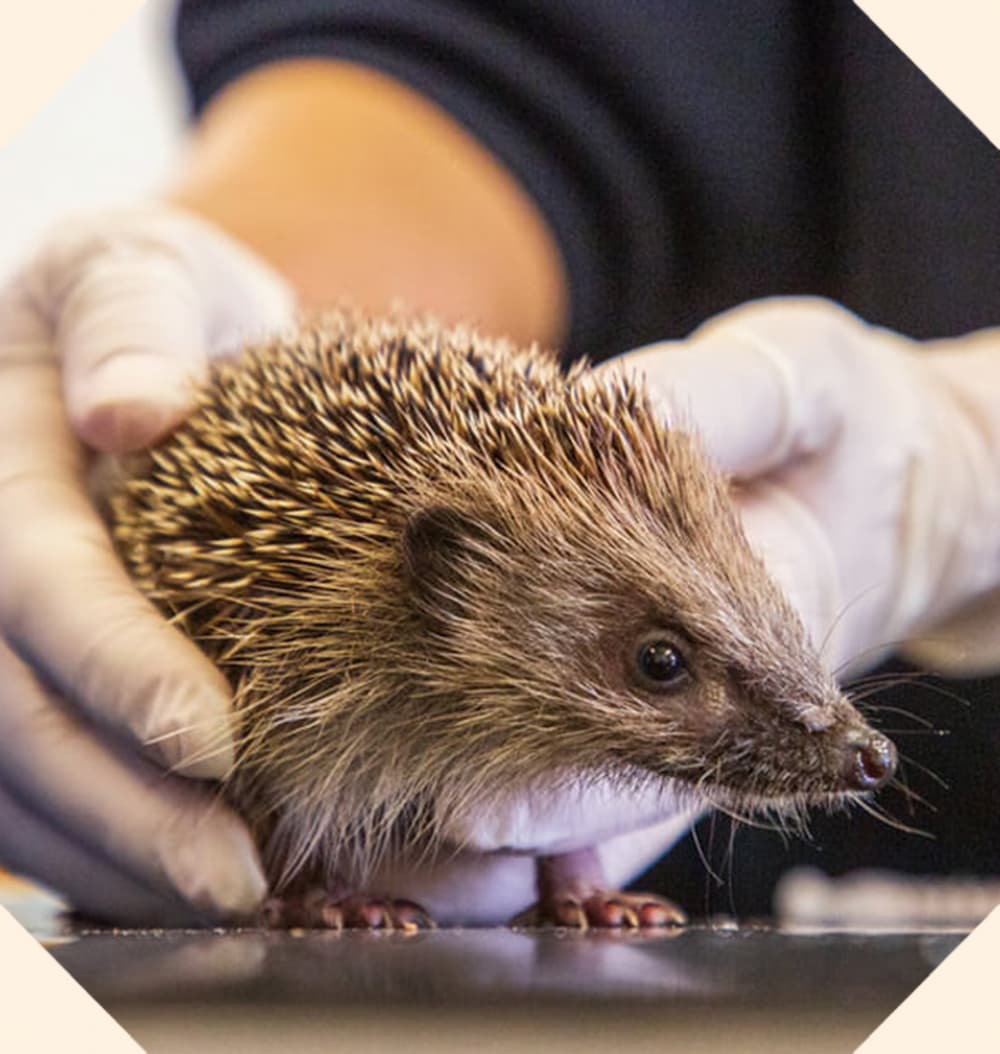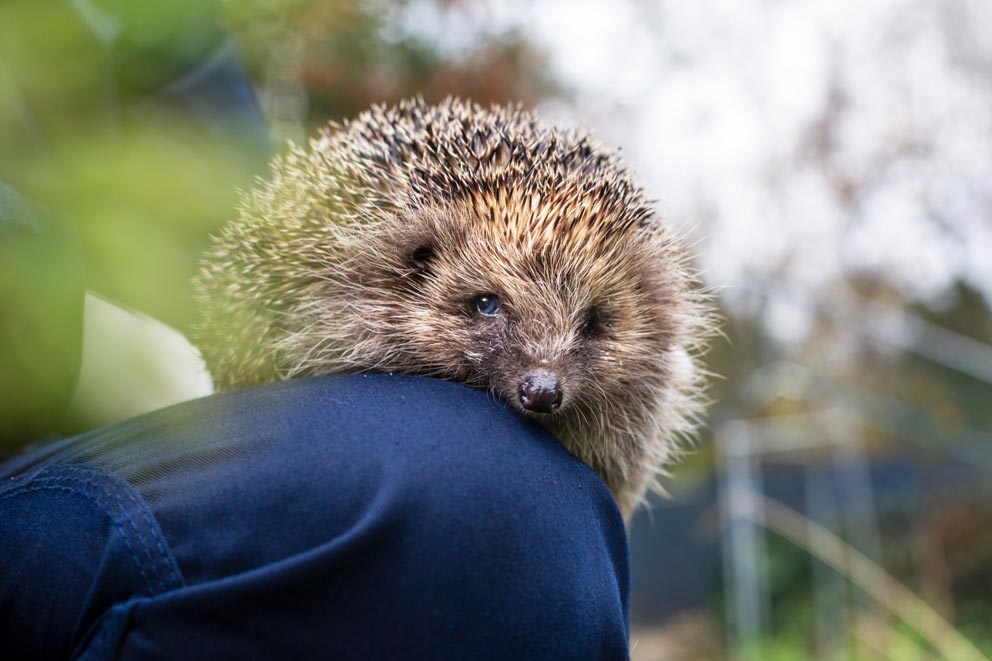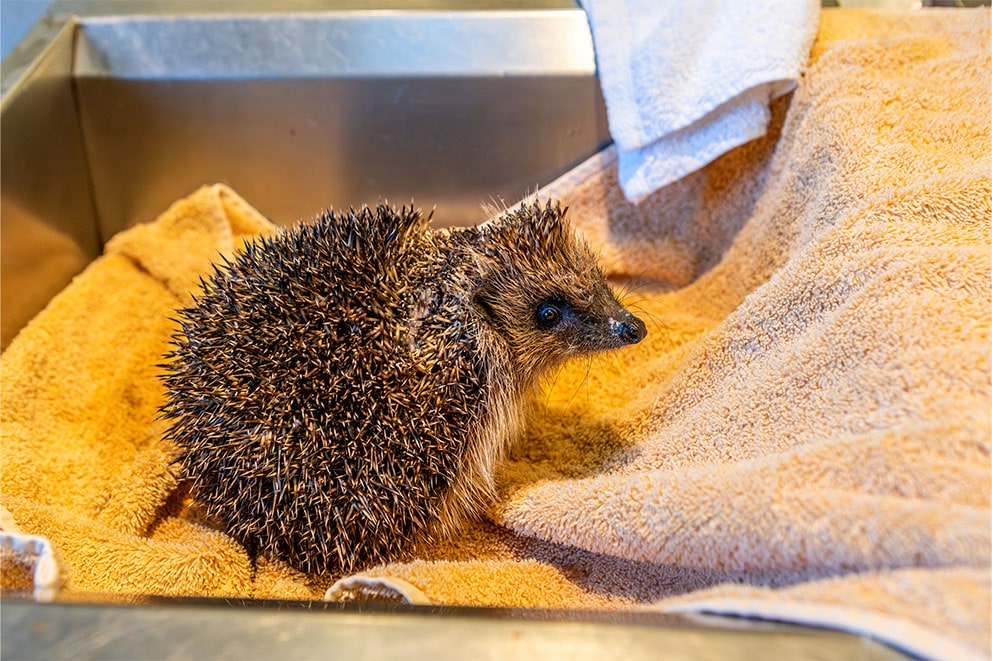An adult hedgehog has between 5,000 and 7,000 spines on its little body
Jump to:
How to identify hedgehogs
Our only spiny mammal, hedgehogs are well-known creatures with unique physical features.
Physical features
- Body: Small and round with spines (or ‘spikes’) over their back, and fur covering their faces. A hedgehog can weigh up to 2kg, and they’re typically 15cm to 30cm in length, with a tail only 1cm to 2cm long and legs that are longer than you might think – up to 10cm! – hidden beneath their spines.
- Colour: Hedgehogs are usually brown, though some can be albino or even blonde. Their spines are mostly yellow-tipped.
- Spines: Hedgehog spines are around 2cm to 3cm in length, made of keratin (the same protein that makes up human hair and nails!). Over time, hedgehogs shed their spines, which are then swiftly replaced by new ones, just like our hair.
- Eyes and ears: Hedgehogs have pretty poor eyesight, so they instead rely on their sense of smell to get around and hunt for food. Hedgehogs have short ears, mostly concealed by their fur.
Test your hog knowledge
test your knowledge
You're wrong.
Where and when you might see them
Hedgehogs can be found all across the UK (though there are some Scottish Islands where you won’t find any, and others where non-native hedgehogs have been introduced), in habitats like grassland, heathland and moorland, as well as farmland, woodland, parks and gardens. As the name suggests, hedgehogs love hedges, bushes and long grass full of bugs to feast on, as well as safe places to shelter.
You’re much more likely to see hedgehogs at night, as they’re nocturnal creatures. Before hibernation season – from November to mid-March – you might find them out and about foraging for food and collecting nesting material. They emerge from hibernation in spring.
If you spot a hedgehog during the daytime, there’s a chance it might be sick or injured. Find out how to tell if a hedgehog needs help, and what to do if so.
How to spot signs of hedgehogs:
Hedgehogs roam at night, so you might only know they’ve visited by the signs they leave behind, such as:
- Poop: Hedgehog droppings are usually around 5 cm in length, cylindrical and dark, full of insect and worm bits. If the poo looks green, slimy, sticky or mucus-covered, this could be a sign that the hedgehog is sick.
- Footprints: Hedgehog’s front feet leave tracks that look like tiny handprints, whilst their back feet are longer and more narrow. They have five toes on each foot, though only four may be visible in the track.
- Noise: Hedgehogs are surprisingly noisy. You might hear them snuffling and huffing outside as they forage (or when they’re mating!).
Test your hog knowledge
Baby or young hedgehogs – called hoglets – are born with their spines beneath their skin
test your knowledge
You're wrong.
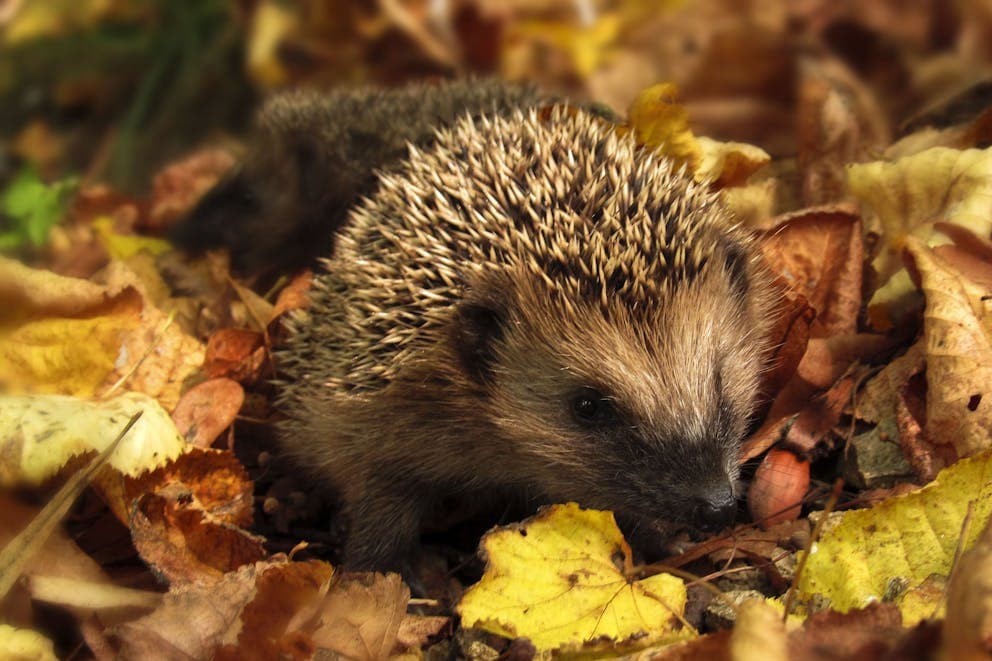
“Hedgehogs use their strong sense of smell to identify and communicate with each other, and make a range of sounds, such as quacking when annoyed."
How long do hedgehogs live?
Hedgehogs can live for as long as two to three years, but there are things that can cause a premature death, such as garden accidents, road incidents, bonfires and loss of natural habitats affecting sources of food and shelter.
Hedgehogs are most at risk when:
- They are hoglets: As they’re vulnerable to predators and their first winter.
- During autumn: If they’re unable to build up enough fat reserves before hibernation. There’s also an increase of lungworm in autumn.
- They’re older: As they age, hedgehog teeth wear down, making it harder to chew and digest food.
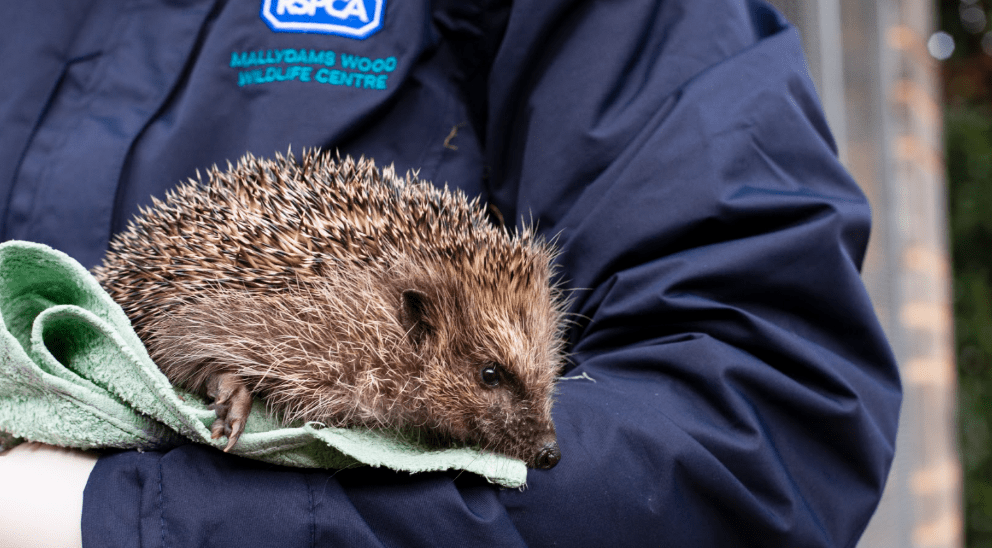
Found a sick or injured hedgehog?
Strimmer accidents, unchecked bonfires, open ponds or netting left lying around are all risks to a hedgehog’s safety. If you find a sick or injured hedgehog in your garden, learn how you can help.
Hedgehog population
A mammal survey conducted in 2018 suggests that the hedgehog population was then around 879,000, with a quarter of that number in urban areas like gardens and parks.
However, over half of our hedgehogs have disappeared from the countryside since 2000, and they’re now absent in a third of towns and cities.
This decline is partly due to a loss of natural habitat, which provides both shelter and food for hedgehogs. Fencing, pesticides, garden hazards (like ponds, strimmers and netting) and development and construction also have an impact. And of course, cars are a major threat to hedgehogs, killing thousands each year.
Are hedgehogs legally protected?
Hedgehogs are indirectly protected by the law:
- It’s illegal to kill or capture wild hedgehogs, with certain listed methods (Wildlife and Countryside Act, 1981).
- Cruel treatment of hedgehogs is prohibited (Wild Mammals Protection Act, 1996).
- Hedgehogs are considered a species of ‘principal importance’ under the NERC Act.
- Hedgehogs that have been caught, marked and tagged are also protected by the Animal Welfare Act 2006.
Yet none of these acts address the reasons behind hedgehog decline. Find out more information on wildlife laws in the UK.
Test your hog knowledge
The hedgehog population on the Channel island of Alderney is 25% blonde
test your knowledge
You're wrong.
1-2 miles
Hedgehogs can travel per night
5,700
Spines on an adult hedgehog’s body
10cm
is the length of a hedgehog’s legs
What do hedgehogs eat?
Hedgehogs eat a wide variety of food, though they’re mostly insectivorous, so they’ll prey on beetles, caterpillars and earthworms – which is why they’re gardeners’ friends!
Occasionally they may eat amphibians, small rodents and birds that are already dead, slugs and snails, birds’ eggs and even fruit. They’ll also take advantage of carrion (decaying animal flesh) if nearby.
Hedgehog diets are dependent on the season:
- Spring: Hedgehogs eat more snails and slugs.
- Summer: With a lot of plants available, hedgehogs can also eat lots of berries and fruit.
- Autumn: Hedgehogs eat as much as they can, stocking up on fats for hibernation.
- Winter: Hedgehogs are hibernating!
However, a hedgehog’s diet has been greatly impacted by the loss and damage of habitats and the use of pesticides on farms and in gardens.
If you want to help a hedgehog ready itself for hibernation, or simply supplement their existing diets, find out what to feed them on our hedgehogs in the garden page.
Did you know?
Hedgehogs are lactose intolerant.
This means you should never leave milk out for them – or bread (which isn’t very nutritious to hedgehogs).
When do hedgehogs hibernate?
Hedgehogs hibernate between October or November to around mid-March to April, but it depends on the weather. If it’s mild, they might still be active into December.
During hibernation, hedgehogs aren’t truly asleep – they drop their body temperature to match their environment, and enter what’s called a state of ‘torpor’. This is when an animal's temperature, metabolic rate and other bodily functions are lowered to conserve energy.
If you see a hedgehog during the winter, don’t worry. Hedgehogs often wake up from hibernation to forage for food or move their nest before going back to sleep. Keep your eye on them, just in case their hibernation has been disturbed and they need help.
Hedgehogs survive the winter by using up the fat stores they’ve built over the spring and summer. Eating enough nutritious and fatty foods during those months is vital – and this is when supplementary feeding (such as leaving out meaty cat or dog food in your garden for them) can help.
In spring, they reemerge into the wild, waiting for the sun to go down before heading out to begin feasting ahead of the next winter.
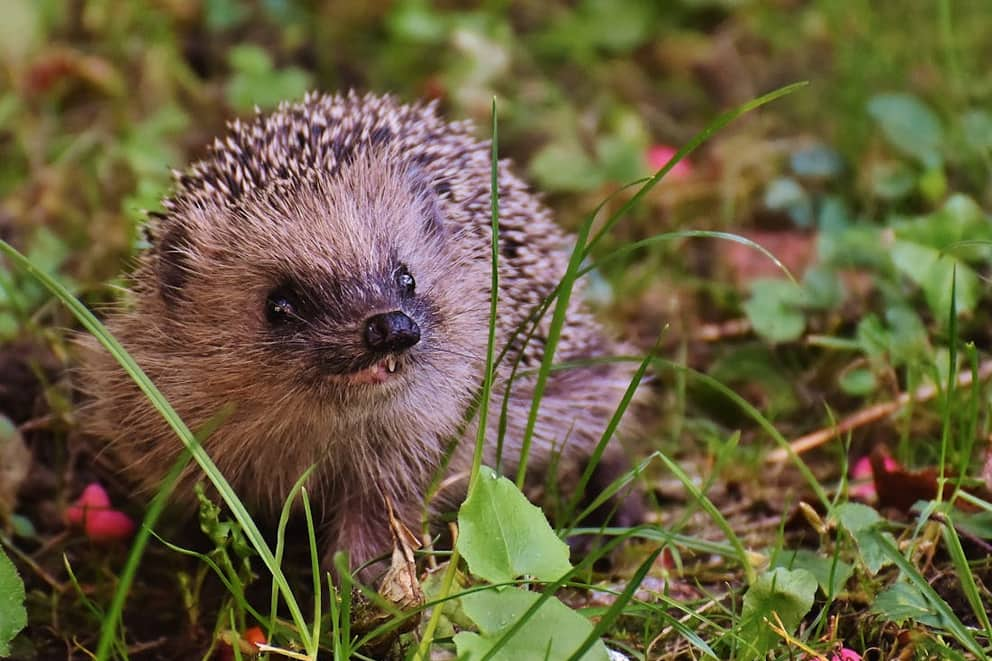
Did you know?
Hedgehogs build nests to hibernate in called a ‘hibernaculum’. These are usually a leaf pile or log pile.
(Sometimes those used for bonfires, so always check your bonfire before lighting it).
Hedgehog body language
Hedgehogs, like humans, use their body language to express what they’re feeling – often with their spines.
If a hedgehog’s spines are down – they’re probably relaxed and comfortable.
If you see a hedgehog with its spines up – it most likely feels threatened. Hedgehogs have a muscle that allows them to curl up into a tight and spiky ball, contracting them like a draw-string bag.
They’re also incredibly good runners, climbers and can even swim!
Hedgehogs communicate with their faces; forehead furrowing, nose twitching and eyebrows covering their eyes are all used to express relaxation, curiosity, fear and more.
They’re noisy animals! Often heard huffing and puffing whilst out foraging and collecting nest material.
Like us, hedgehogs experience an abundance of emotions each and every day. The more you learn about them, the more you can understand what they’re feeling and what they might need.
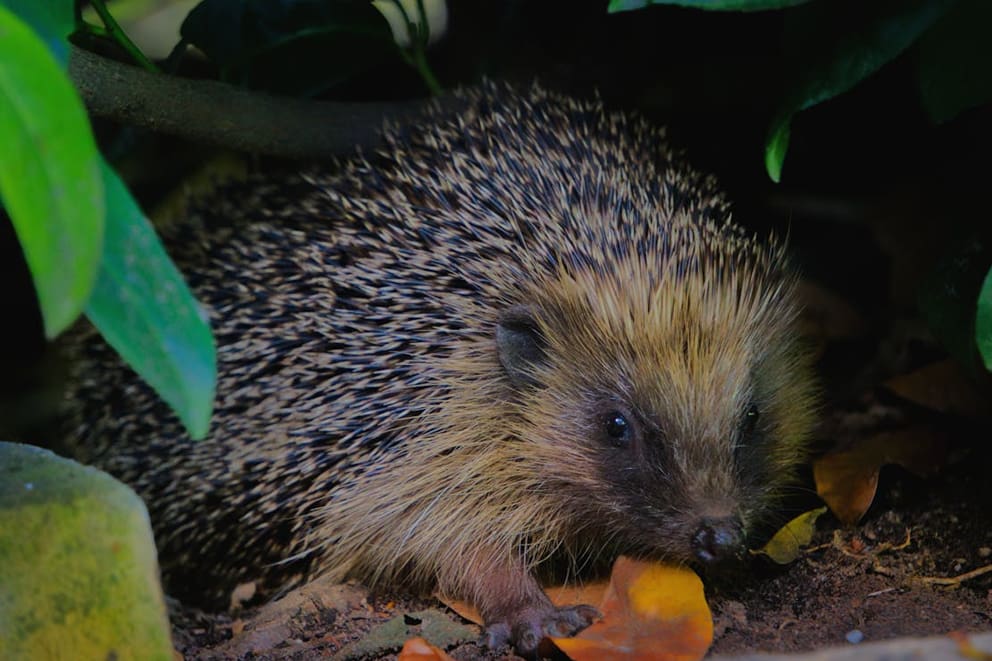
When do hedgehogs breed?
Hedgehog breeding
Hedgehogs breed in the spring and summer, mostly during May and June, though they’re able to reproduce between April and September. Both male and female hedgehogs can mate several times a year with multiple partners.
A hedgehog mating ritual – which involves males attempting to woo the females – can be lengthy and quite loud. It often attracts rival mates, who can square up to one another, butt heads and chase each other.
Hedgehog breeding
A hedgehog female is pregnant for around four weeks. During this time, she’ll start building a nursery nesting site for her litter.
Hedgehog birth
Hedgehogs typically give birth in June and July, though baby hedgehogs (hoglets) can appear as early as the spring (after a mild winter) or into autumn. Hoglets are born blind and deaf, with white spines that appear soon after birth.
They'll start leaving the nest to forage with their mother at around four-weeks old – hedgehog mums carry hoglets around in their mouths – and will be independent by about eight weeks.
Litters usually consist of around four to five hoglets, but can be as many as seven! Sadly, usually only two or three hoglets survive the weaning period. Mother hedgehogs can sometimes leave their hoglets, or even eat them if disturbed.
Found an injured or abandoned baby hedgehog? Find out how to help.
Test your hog knowledge
The scientific name for West European hedgehogs is Erinaceus europaeus.
test your knowledge
Your answer is incorrect.
How the RSPCA helps hedgehogs
Between 2020-2024, our four wildlife centres admitted more than 9,500 hedgehogs, to help treat, rehabilitate and prepare them to return to the wild.
We’re also incredibly grateful to those of you who’ve learnt how to help hedgehogs and taken action to rescue them yourselves. You’ve helped free up our rescuers to get to the animals that need us most – those at risk of cruelty and neglect.
